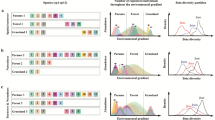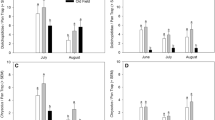Abstract
Context
Changes in land use have disruptive effects on community structure, causing many species to disappear, though a few thrive and become pests.
Objectives
To gain understanding on how anthropogenic activity changes spatial patterns of native species diversity while favoring pests, we conducted rapid biodiversity assessments of dacine fruit flies across eight regions in Southeast Asia.
Methods
Male lure traps were maintained for 2 days along transects at 233 sites, in forest, agricultural and urban environments.
Results
A total of 8393 individuals were collected, belonging to 57 described and 4 new or unidentified species. The majority (78 %) of individuals belonged to 14 pest species, dominated by Bactrocera dorsalis (Hendel). The 57 species represent 38 % of those recorded from the region, indicating effective sampling. Individual flies were collected in highest numbers in urban and agricultural sites, but species diversity was low. Forest samples yielded fewer specimens but highest species diversity, suggesting a shift in community structure after disturbance, benefiting a few pest species at the expense of the broader community, even in the same genus and ecological guild.
Conclusions
Dacine fruit flies may be useful in assessing habitat quality and bait systems permit the execution of rapid biodiversity and multi-species conservation assessments. Our results apply to broader patterns concerning biodiversity loss and the emergence of pest species under increasingly intensive land use gradients, and demonstrate the remarkable loss of biodiversity over very narrow distances as forest is converted into agricultural use, hence the importance in maintaining a mosaic of native habitats.






Similar content being viewed by others
References
Allwood AJ, Chinajariyawong A, Drew RAI, Hamacek EL, Hancock DL, Hengsawad C, Jipanin JC (1999) Host plant records for fruit flies (Diptera: Tephritidae) in South East Asia. Raffles Bull Zool Suppl 7:1–92
Aluja M, Rull J, Sivinski J, Norrbom AL, Wharton RA, Macías-Ordóñez R, Díaz-Fleischer F, López M (2003) Fruit Flies of the Genus Anastrepha (Diptera: Tephritidae) and Associated Native Parasitoids (Hymenoptera) in the Tropical Rainforest Biosphere Reserve of Montes Azules, Chiapas, Mexico. Environ Entomol 32:1377–1385
Basset Y, Missa O, Alonso A, Miller SE, Curletti G, De Meyer M, Eardley CD, Mansell MW, Novotny V, Wagner T (2008a) Choice of metrics for studying arthropod responses to habitat disturbance: one example from Gabon. Insect Conserv Diversity 1:55–66
Basset Y, Missa O, Alonso A, Miller SE, Curletti G, De Meyer M, Eardley CD, Mansell MW, Novotny V, Wagner T (2008b) Faunal turnover of arthropod assemblages along a wide gradient of disturbance in Gabon. Afr Entomol 16:47–59
Bateman PW, Fleming PA (2012) Big city life: carnivores in urban environments. J Zool 287:1–23
Buckland ST (2006) Point-transect surveys for songbirds: robust methodologies. Auk 123:345–357
Cardoso P, Borges PAV, Triantis KA, Ferrández MA, Martín JL (2011) Adapting the IUCN Red List criteria for invertebrates. Biol Conserv 144:2432–2440
Cardoso P, Borges PAV, Triantis KA, Ferrández MA, Martín JL (2012) The underrepresentation and misinterpretation of invertebrates in the IUCN Red List. Biol Conserv 149:147–148
Caro T (2010) Conservation by proxy. Indicator, umbrella, keystone, flagship, and other surrogate species. Island Press, Washington
Chao A, Chazdon RL, Colwell RK, Shen TJ (2005) A new statistical approach for assessing similarity of species composition with incidence and abundance data. Ecol Lett 8:148–159
Clarke AR, Allwood AJ, Chinajariyawong A, Drew RAI, Hengsawad C, Jirasurat M, Kong Krong C, Kritsaneepaiboon S, Vijaysegaran S (2001) Seasonal abundance and host use patterns of seven Bactrocera species Macquart (Diptera: Tephritidae) in Thailand and Peninsular Malaysia. Raffles Bull Zool 49:207–220
Clarke AR, Balagawi S, Clifford B, Drew D, Leblanc L, Mararuai A, McGuire D, Putulan D, Roming TG, Sar S, Tenakanai D (2004) Distribution and biogeography of Bactrocera and Dacus species (Diptera: Tephritidae) in Papua New Guinea. Aust J Entomol 43:148–156
Cognato A, Rubinoff D (2008) New exotic ambrosia beetles found in Hawaii (Curculionidae: Scolytinae: Xyleborina). Coleopt Bull 62:421–424
Colwell RK (2013) EstimateS: Statistical estimation of species richness and shared species from samples. Version 9. User’s Guide and application. http://purl.oclc.org/estimates. Accessed Aug 2013
Dennil GB, Moran VC (1989) On insect-plant associations in agriculture and the selection of agents for weed biocontrol. Ann Appl Biol 114:157–166
Drew RAI (1989) The tropical fruit flies (Diptera: Tephritidae: Dacinae) of the Australasian and Oceanian regions. Mem Qld Mus 26:1–521
Drew RAI, Romig MC (2001) The fruit fly fauna (Diptera: Tephritidae: Dacinae) of Bougainville, the Solomon Islands and Vanuatu. Aust J Entomol 40:113–150
Drew RAI, Romig MC (2013) Tropical Fruit Flies (Tephritidae: Dacinae) of South-East Asia: Indomalaya to North-West Australasia. C.A.B. International, Oxfordshire
Drew RAI, Zalucki MP, Hooper GHS (1984) Ecological studies of eastern Australian fruit flies (Diptera: Tephritidae) in their endemic habitat I. Temporal variation in abundance. Oecologia 64:267–272
Duyck PF, David P, Quilici S (2004) A review of relationships between interspecific competition and invasions in fruit flies (Diptera: Tephritidae). Ecol Entomol 29:511–520
Ekesi S, Billah MK, Nderitu PW, Lux SA, Rwomushana I (2009) Evidence for competitive displacement of Ceratitis cosyra by the invasive fruit fly Bactrocera invadens (Diptera: Tephritidae) on mango and mechanisms contributing to the displacement. J Econ Entomol 102:981–991
Fleishman E, Murphy DD (2009) A realistic assessment of the indicator potential of butterflies and other charismatic taxonomic groups. Conserv Biol 23:1109–1116
Garcia-Vallvé S, Puigbo P (2002) DendroUPGMA: A dendrogram construction utility. http://genomes.urv.cat/UPGMA/. Accessed Aug 2013
Hancock DL, Hamacek EL Lloyd AC, Elson-Harris MM (2000) The distribution and host plants of fruit flies (Diptera: Tephritidae) in Australia. Queensland DPI Inform Series QI99067:1–75
Huryn AD, Slavik KA, Lowe RL, Parker SM, Anderson DS, Peterson BJ (2005) Landscape heterogeneity and the biodiversity of Arctic stream communities: a habitat template analysis. Can J Fish Aq Sci 62:1905–1919
Jhala YV, Gopal R, Qureshi Q (2008) Status of tigers, co-predators and prey in India. National Tiger Conservation Authority and Wildlife Institute of India, New Delhi and Dehradun
Jones ME, Paine TD (2006) Detecting changes in insect herbivore communities along a pollution gradient. Env Poll 143:377–387
Lassau SA, Hochuli DF, Cassis G, Reid CAM (2005) Effects of habitat complexity on forest beetle diversity: do functional groups respond consistently? Divers Distrib 11:73–82
Leblanc L, San Jose M , Barr N, Rubinoff D (2015a) A phylogenetic assessment of the polyphyletic nature and intraspecific color polymorphism in the Bactrocera dorsalis complex (Diptera, Tephritidae). Zookeys (in press)
Leblanc L, San Jose M, Rubinoff D (2015b) Description of a new species and new country distribution records of Bactrocera (Diptera: Tephritidae: Dacinae) from Cambodia. Zootaxa 4012:593-600
Leblanc L, Vueti ET, Allwood AJ (2013a) Host plant records for fruit flies in the Pacific Islands: 2. Infestation statistics on economic hosts. Proc Hawaiian Entomol Soc 45:83–117
Leblanc L, Hossain MA, Khan SA, San Jose M, Rubinoff D (2013b) A preliminary survey of the fruit flies (Diptera: Tephritidae: Dacinae) of Bangladesh. Proc Hawaiian Entomol Soc 45:51–58
Lips KR, Brem F, Brenes R, Reeve JD, Alford RA, Voyles J, Carey C, Livo L, Pessier AP, Collins JP (2006) Emerging infectious disease and the loss of biodiversity in a Neotropical amphibian community. PNAS 103:3165–3170
Mwatawala MW, De Meyer M, Makundi RH, Maerere AP (2006) Biodiversity of fruit flies (Diptera: Tephritidae) in orchards in different agro-ecological zones of the Morogoro region, Tanzania. Fruits 61:321–332
Novotny V, Miller SE, Hulcr J, Drew RA, Basset Y, Janda M, Setliff GP, Weiblen GD (2007) Low beta diversity of herbivorous insects in tropical forests. Nature 448:692–695
Obrist MK, Duelli P (2010) Rapid biodiversity assessment of arthropods for monitoring average local species richness and related ecosystem services. Biodivers Conserv 19:2201–2220
Oliver I, Beattie J (1996) Designing a cost-effective invertebrate survey: a test of methods for rapid assessment of biodiversity. Ecol Appl 6:594–607
Pape T, Bickel D, Meier R (eds) (2009) Diptera diversity: status, challenges and tools. Brill, Leiden
Pimentel D (1993) Habitat-factors in new pest invasions. In: Kim KC, McPheron BA (eds) Evolution of insect pests, patterns of variation. Wiley, New York, pp 165–181
Raghu S, Clarke AR (2000) Impact of habitat modification on the distribution and abundance of fruit flies (Diptera: Tephritidae) in southeast Queensland. Popul Ecol 42:153–160
Rondeau D, Conrad JM (2003) Managing urban deer. Am J Agr Econ 85:266–281
San Jose M, Leblanc L, Geib SM, Rubinoff D (2013) An evaluation of the species status of Bactrocera invadens and the systematics of Bactrocera dorsalis (Diptera: Tephritidae) complex. Ann Entomol Soc Am 106:684–694
SAS Institute (2011) SAS/STAT 9.3 User’s guide. SAS Institute, Cary, NC
Shelly T, Epsky N, Jang EB, Reyes-Flores J, Vargas RI (eds) (2014) Trapping tephritid fruit flies. Lures, area-wide programs, and trade implications. Springer, Dordrecht
Simberloff D (1998) Flagships, umbrellas, and keystones: Is single-species management passé in the landscape area? Biol Conserv 83:247–257
Tan KH, Lee SL (1982) Species diversity and abundance of Dacus (Diptera: Tephritidae) in five ecosystems of Penang, West Malaysia. Bull Entomol Res 72:709–716
Tan KH, Serit M (1988) Movements and population density comparisons of native male adult Dacus dorsalis and Dacus umbrosus (Diptera: Tephritidae) among three ecosystems. J Plant Prot Tropics 5:17–21
Ter Braak CJF, Smilauer P (2002) CANOCO reference manual and CanoDraw for Windows user’s guide: Software for canonical community ordination (version 4.5). Ithaca, New York, (www.canoco.com): Microcomputer power
Thoisy B, Brosse S, Dubois MA (2008) Assessment of large-vertebrate species richness and relative abundance in Neotropical forest using line-transect censuses: what is the minimal effort required? Biodivers Conserv 17:2627–2644
Vargas RI, Leblanc L, Putoa R, Pinero JC (2012) Population dynamics of three Bactrocera spp. fruit flies (Diptera: Tephritidae) and two introduced natural enemies, Fopius arisanus (Sonan) and Diachasmimorpha longicaudata (Ashmead) (Hymenoptera: Braconidae), after an invasion by Bactrocera dorsalis (Hendel) in Tahiti. Biol Control 60:199–206
Vargas RI, Piñero JC, Leblanc L (2015) An overview of the pest species of Bactrocera fruit flies (Diptera: Tephritidae) an the integration of biopesticides with other biological approaches for their management with focus on the Pacific region. Insects 6:297–318
White IM (2006) Taxonomy of the Dacina (Diptera: Tephritidae) of Africa and the Middle East. Afr Entomol Mem 2:1–156
White IM, Elson-Harris MM (1992) Fruit flies of economic significance: their identification and bionomics. C.A.B. International, Wallingford
Zalucki MP, Drew RAI, Hooper GHS (1984) Ecological studies of Eastern Australian fruit flies (Diptera: Tephritidae) in their endemic habitat. II. The spatial pattern of abundance. Oecologia 64:273–279
Acknowledgments
Collecting trips in Asia were funded through USDA-ARS Specific Cooperative Agreements 58-5320-9-382 and 58-5320-4-018, managed by the University of Hawaii’s College of Tropical Agriculture and Human Resources (UH-CTAHR). We greatly appreciate the help of Chi-Yeh Chien (Thai Royal Project Foundation), Johannes Ketellar (Chief Technical Advisor, FAO Inter-Country Programme for IPM, Thailand), Thongsavanh Taipangnavong and Vornthalom Chanthavong (FAO-IPM, Laos), Lira Chea and Ajay Markanday (FAO-IPM Cambodia), Prabhat Kumar (Asian Institute of Technology, Thailand) and Po-Yung Lai (UH-CTAHR), for permits and logistics in our fieldwork. Saba Young, Dan Nitta and Christopher Guo helped with molecular work. Dick Drew (Griffith University, Australia) provided the senior author with extensive training on fruit fly taxonomy over the years and has verified many of our species determinations. This work was made possible, in part, by a Cooperative Agreement from the United States Department of Agriculture through Farm Bill funding (project 3.0251) administered by the College of Tropical Agriculture and Human Resources. Additional research funding was provided by USDA-National Institute of Food and Agriculture Hatch projects HAW00942-H and HAW00956-H, administered by UH-CTAHR.
Author information
Authors and Affiliations
Corresponding author
Electronic supplementary material
Below is the link to the electronic supplementary material.
Rights and permissions
About this article
Cite this article
Leblanc, L., Jose, M.S., Wright, M.G. et al. Declines in biodiversity and the abundance of pest species across land use gradients in Southeast Asia. Landscape Ecol 31, 505–516 (2016). https://doi.org/10.1007/s10980-015-0276-3
Received:
Accepted:
Published:
Issue Date:
DOI: https://doi.org/10.1007/s10980-015-0276-3




